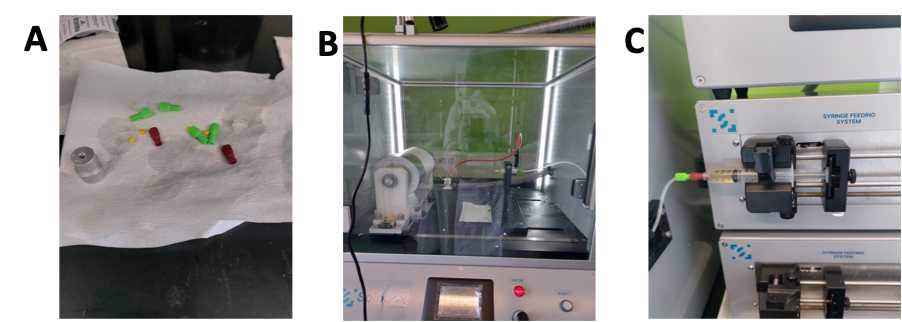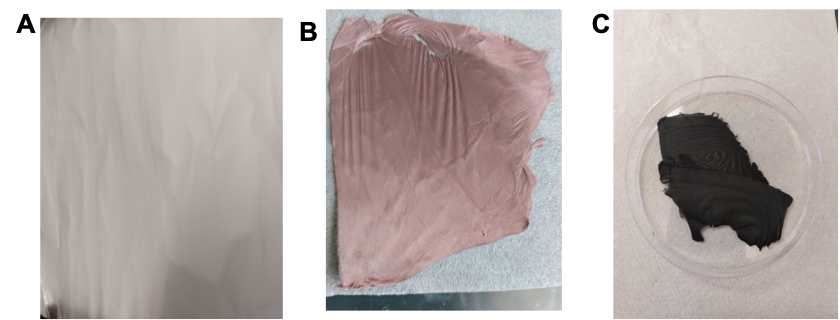Synthesis of Carbon Nanofibers by Electrospinning
Eric S McLamore, Raphael D. Ayivi, Bukola Adesanmi, Sherine O. Obare
Disclaimer
This work was conducted at the Joint School of Nanoscience and Nanoengineering (JSNN), a member of the Southeastern Nanotechnology Infrastructure Corridor (SENIC) and National Nanotechnology Coordinated Infrastructure (NNCI), which is supported by the US National Science Foundation (ECCS-2025462). We acknowledge support from the US NSF EiR research grant (award#: 1832134) and the NSF-funded STEPS Center (award#: CBET-2019435).
Abstract
This protocol describes the synthesis of aligned carbon nano fiber for adsorbent/photocatalyst in
environmental samples, electrochemical energy storage and other industrial
applications. The steps for the process are based on Zeng et a1 1 summarized i Figure 1 1.
Before start
Ensure ample, clean benchtop space is available for reagent preparation* Ensure access to well ventilated area (e.g., certified hood)
- Use of Safety shut-off switches equipment is encouraged to ensure safety during high voltage operation.
- More safety information on use of electrospinning equipment (More safety information)
Steps
Solution preparation
Step 1) Prepare 10% PAN working solutions (Timing: 24 hours)
- Weigh 3g of polyacrylonitrile and carefully combine in a flask with 27g of dimethyl formamide (DMF) under a chemical fume hood.
- Place on magnetic stirrer within chemical hood ( Figure 1 )
- Stir the mixture at 300 to 400rpm for 24 hours.
- Inspect to ensure the solution is completely homogenized (no visible particulate matter) in form of a clear viscous solution.
- The solution may be stored for at least one month when stored at 4C. Care should be taken when storing the solution at room temperature 3

Instrument preparation
Step 2) Instrument Set up and preparation (Timing: 20 minutes)
- Insert a green ferrule followed by the yellow ferrule to each end of the Polyethylene tube (the length of the tube is determined by the distance of the pump to the mounting stage)
- If the PAN solution is not used immediately, stir the already dissolved polymer solution for an additional 10-15 minutes at 400 rpm before use and inspect to ensure a homogeneous solution.
- Decant the polymer solution slowly into a 10ml BD syringe.
- Use a gloved finger to hold the tip or cap on the syringe to prevent spilling.
- Alternatively, slowly use the syringe to draw the polymer solution into the syringe.
- Turn the syringe upside down and agitate slowly so that any bubbles rise to the top of the solution.
- Push the plunger slowly to remove any air bubbles made during the process.
- Use a Kimwipe or adsorbent cloth to clean any small droplets of polymer solution from the syringe.
- Attach the syringe to the tube and connect to the spinning head.
- Insert electrospinning needle into the spinning head.
- Push the plunger slowly to transport solution into the tubing.
Step 3) Load the syringe into electrospinning instrument (Timing: 5 minutes)
- Load the spinning head into the feeding stand of the machine ( Figure 2 ).
- Load the syringe in the feeding pump.
- Lock the screw to hold it slightly tight.

Step 4) Connect electrical system (Timing: 2 minutes)
- Connect the voltage line of the machine to the feeding stand on the electrospinning instrument.
- Set the voltage line on the feeding stand
- Lock the screw.
Step 5) Load the collector (Timing: 5 minutes)
- Load the fiber collector with clean aluminum foil.
- Use tape to secure it the foil on the fiber collector
Process and Collect Fiber
Step 6) Electrospinning nanofiber (Timing: 5 hours)
- Turn on the computer for the electrospinning instrument
- Open the spinning software and set up the parameters accordingly:
- Switch on the rotating drum collector and adjust the rotating speed appropriately:
- Set the spinning voltage by adjusting the knob to the required voltage (Voltages between 12KV-18KV are appropriate for this protocol)
- Start the process and run the instrument for 5 hours (or more depending on the parameter setting)
Step 7) Collect electro-spun nanofibers (Timing: 5 hours)
- After turning off the power source, drum and feeding pump, remove the spun fibers from the aluminum foil
- Store fibers in fume hood
- Clean the ferrule and other accessories with (DMF). Capture any excess DMF in a glass beaker or other appropriate waste container
- Dispose of the waste DMF/PAN in the chemical disposal area
Stabilize and Carbonize Fibers
Step 8) Stabilize electro-spun fibers (Timing: 8 hours)
- Cut the spun fiber into desired sizes of available graphite plate
- Place the cut fibers on graphite plate
- Place graphite plate and fibers into furnace
- Bake the electro spun fibers in air at 280 °C for 6 hours at a heating rate of 1°C per minute.
- Inspect the material after stabilization (baking).
- A brown colored fiber should be achieved after stabilization ( Figure 3 ).

Step 9) Carbonize fibers (Timing: 1 hour)
- While the carbon nano fiber is still in the oven, carbonize in nitrogen at 1200 °C for 1 hour at a heating rate of 5 °C per minute.
- A black colored material should be achieved after the carbonization step ( Figure 4 ).

Clean up
Step 10) Clean up laboratory (Timing: 10 min) Timing : 10 min)
- Clean workstation/benchtop
- Ensure electrospinning instrument is turned off
- Ensure furnace is turned off
- Vials of unused polymers and solvent should be discarded in the waste container and not disposed of in the sink.
- All waste DMF/PAN should be discarded in the satellite chemical disposal area

